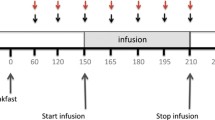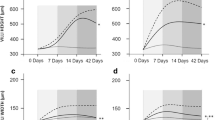Abstract
Optimal absorption of fat requires adequate time of contact with the absorptive sites of the small intestine. In order to prevent steatorrhea, intestinal transit must be slowed in response to the fat that has emptied into the small intestine. Intestinal transit is known to be inhibited by fat in the ileum via the ileal brake. This response has suggested that the regulation of intestinal transit is a function of the distal small intestine. However, clinical observations suggest that the ileal brake is not the only control mechanism for intestinal transit. In short bowel patients with resection of the ileum, the proportion of fecal fat recovery remained constant even after the fat intake was increased threefold. In these patients, optimal fat absorption based on the slowing of intestinal transit must have been triggered by an inhibitory mechanism located outside of the distal small intestine. To test the hypothesis that fat in the proximal small intestine inhibited intestinal transit, we compared intestinal transit during perfusion of the proximal half of the small intestine with 0 (buffer only), 15, 30, or 60 mM oleate in dogs equipped with duodenal and mid-intestinal fistula. Intestinal transit across a 150-cm test segment (between fistulas) was measured by counting for the recovery of a radioactive marker in the output of the mid-intestinal fistula during the last 30 min of a 90-min perfusion. We found that oleate inhibited intestinal transit in a load-dependent fashion (P<0.005). Specifically, while the mean cumulative recovery of the transit marker was 95.5% during buffer perfusion, the recovery decreased when 15 mM (64.3%), 30 mM (54.7%), or 60 mM oleate (38.7%) was perfused into the proximal half of the small intestine. We conclude that fat in the proximal small intestine inhibits intestinal transit as the jejunal brake.
Similar content being viewed by others
References
Spiller RC, Trotman IF, Higgins BE: The ileal brake-inhibition of jejunal motility after ileal fat perfusion in man. Gut 25:365–374, 1984.
Read NW, MacFarlane A, Kinsman R: Effect of infusion of nutrient solutions into the ileum on gastrointestinal transit and plasma levels of neurotensin and enteroglucagon in man. Gastroenterology 86:274–280, 1984
Spiller RC, Trotman IF, Adrian TE, Bloom SR, Misiewicz J, Silk DB: Further characterisation of the “ileal brake” reflex in man—effect of ileal infusion of partial digests of fat, protein, and starch on jejunal motility and release of neurotensin, enteroglucagon, and peptide YY. Gut 29:1042–1051, 1988
Borgstrom S, Arborelius J: Influence of a fatty acid on duodenal motility. Scand J Gastroenterol 10:599–601, 1975
Lin HC, Wang LJ, Zhao XT: Completeness of fat absorption by midgut depends on load of fat emptied into duodenum. Am J Physiol (in press)
Gustavsson S, Kelly KA: Effect of gastric and small bowel operations on gastrointestinal motility.In An Illustrated Guide to Gastrointestinal Motility. D Kumar, S Gustavsson (eds). New York, John Wiley & Sons, 1988, pp 291–312
Kremen AJ, Linner JH, Nelson CH: An experimental evaluation of the nutritional importance of proximal and distal small intestine. Ann Surg 140:439–448, 1954
Huge A, Weber E, Ehrlein H-J: Effects of enteral feedback inhibition on motility, luminal flow, and absorption of nutrients in proximal gut of minipigs. Dig Dis Sci 40(5):1024–1034, 1995
Holgate AM, Read NW: Relationship between small bowel transit time and absorption of a solid meal: Influence of metoclopramide, magnesium sulfate and lactulose. Dig Dis Sci 28:812–819, 1983
Woolf GM, Miller C, Kurian R, Jeejeebhoy KN: Diet for patients with a short bowel: high fat or high carbohydrate? Gastroenterology 84(4):823–828, 1983
Lin HC, Doty JE, Reedy TJ, Meyer JH: Inhibition of gastric emptying by glucose depends on length of intestine exposed to nutrient. Am J Physiol 256:G404-G411, 1989
Lin H, Doty J, Reedy T, Meyer J: Inhibition of gastric emptying by sodium oleate depends on the length of intestine exposed to the nutrient. Am J Physiol 259:G1030-G1036, 1990
Johansson C: Studies of gastrointestinal interactions. Scand J Gastroenterol 9(suppl 28):1–60, 1974
Zierler KL: A simplified explanation of the theory of indicator dilution for measurement of fluid flow and volume and other distributive phenomena. Bull Johns Hopkins 103:199–217, 1958
Lin HC, Kim BK, Elashoff JD, Doty JE, Gu YG, Meyer JH: Gastric emptying of solid food is most potently inhibited by carbohydrates in the canine distal ileum. Gastroenterology 102:793–801, 1992
Dixon WJ: BMDP Statistical Software Manual. Berkeley, University of California Press, 1990
Meyer JH: Nutritional outcomes of gastric operations. Gastroenterol Clin North Am 23(2):227–260, 1994
Lin HC, Elashoff JD, Kwok GM, Gu YG, Meyer JH: Nutrient feedback inhibition of gastric emptying plays a larger role than osmotically dependent duodenal resistance. Am J Physiol 28(4):G672-G676, 1993
Meyer JH, Domeck M, Levy A, Jehn D, Hlinka M, Lake R, Graham LS, Gu YG: Control of canine gastric emptying of fat by lipolytic products. Am J Physiol 266(6, Pt 1):G1017-G1035, 1994
Lin HC, Zhao XT, Wang LJ, Wong H: Fat-induced brake depends on peptide YY. Gastroenterology (in press)
Greeley GH, Jeng YJ, Gomez G: Evidence for regulation of peptide-YY release by the proximal gut. Endocrinology 124:1438–1443, 1989
Author information
Authors and Affiliations
Rights and permissions
About this article
Cite this article
Lin, H.C., Zhao, XT. & Wang, L. Jejunal brake. Digest Dis Sci 41, 326–329 (1996). https://doi.org/10.1007/BF02093823
Received:
Revised:
Accepted:
Issue Date:
DOI: https://doi.org/10.1007/BF02093823




